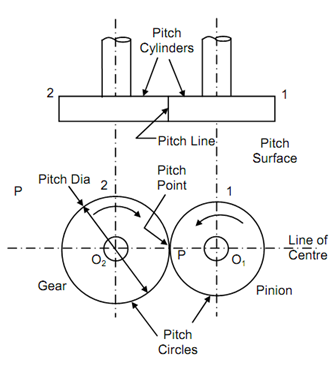Gear Geometry:
In the previous unit, different kinds of drive were explained. Two gears whereas transmitting motion from higher pair. If power transmitted is negligible among the two shafts, the transmission of motion among them may be obtained by utilizing two discs with diameter equivalent to the pitch circle diameter of equivalent gears. You were described terminology of gears and law of gearing. The profile of gear teeth obeys law of gearing. The cycloid and involutes follow law of gearing.
In this unit, we will explain you form of teeth which follow law of gearing. We will analyse transmission of motion among two gears. Given figure shows one of such cases. Gears 1 & 2 have been replaced through two discs. They can also be known as pitch cylinders. The speeds are inversely proportional to the radii of cylinders. As radii are proportional to the number of teeth, thus, the speeds are inversely proportional to the number of teeth. The involutes profile is utilized generally for gears. They have particular qualities which cycloid profile does not contain. But the involutes gears have crisis of interference and methods have been described to avoid interference.

Transmission of Motion between Two Gears
Objectives
After learning this unit, you should be able to
- understand different kind of teeth,
- analyse transmission of motion among spur gears,
- understand problem of interference and apply methods to ignore it, and
- Studies transmission of motion in bevel gears and spiral gears.